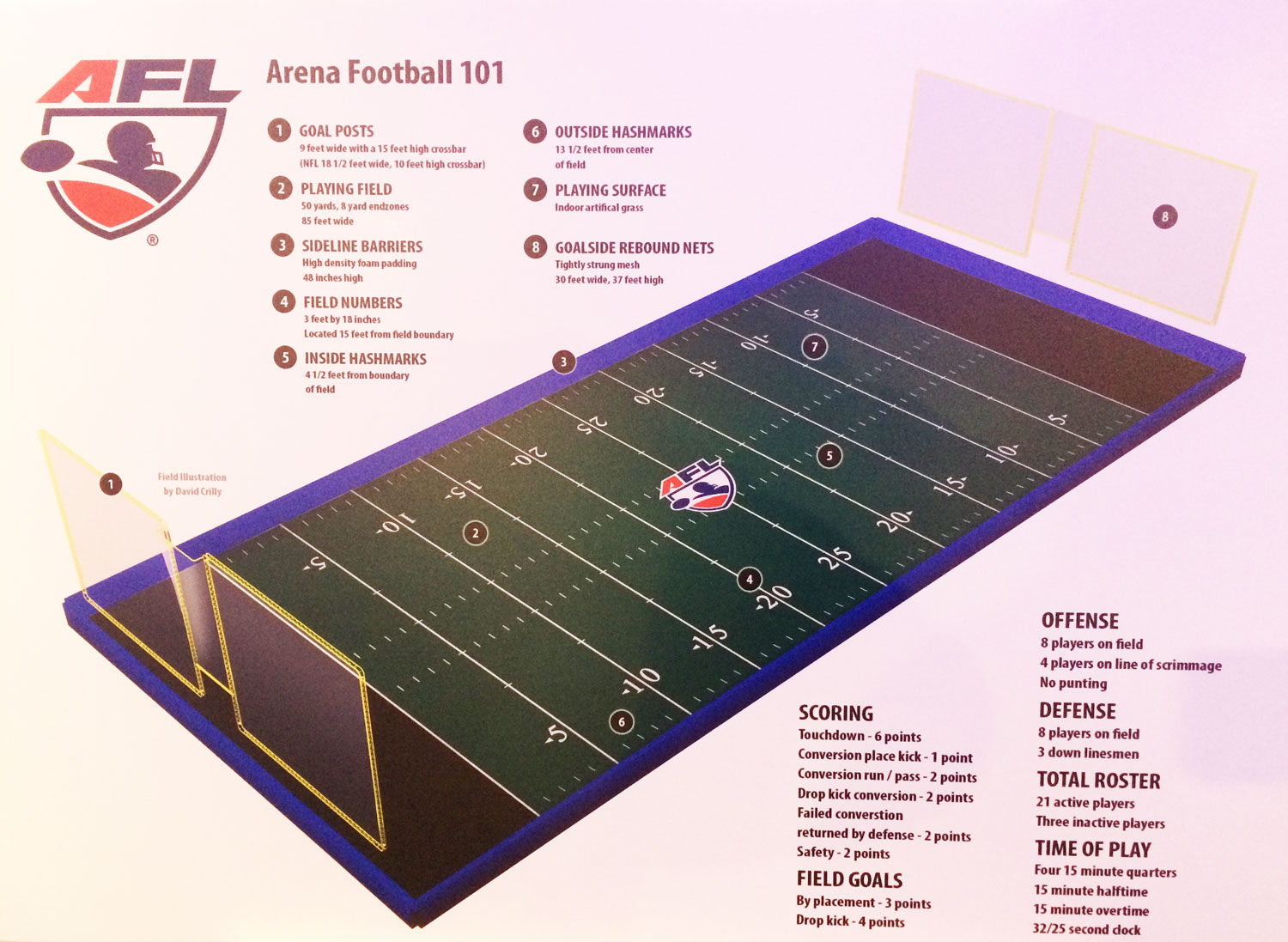A football field is 100 yards in length. A football field measures 100 yards from end zone to end zone, creating a total playing area of 300 feet long.
It is a rectangular playing surface used for the game of American football. The field is divided into two halves by a midfield line, and each half is further divided into 10-yard increments. At each end of the field, there is an end zone that extends 10 yards beyond the goal line.
These measurements are standard in both professional and collegiate football. Understanding the dimensions of a football field is essential for players, coaches, and fans alike, as it provides the framework for gameplay and scoring.

Credit: www.jsonline.com
The Length Of A Football Field
Football is undoubtedly one of the most popular sports in the United States, and its field, known as a football field, plays a crucial role in the game. The length of a football field is an essential dimension that every football fan, player, and coach should be familiar with. In this article, we will explore the standard measurement of a football field, as well as how it compares to other sports.
Standard Measurement
A football field is typically measured in yards, specifically 100 yards in length. This measurement includes both the playing field and the end zones. Each end zone measures 10 yards in length, making the actual playing field 100 yards long and 53 1/3 yards wide. The 10-yard end zones are essential for scoring purposes, as they provide both teams with an opportunity to score points.
Comparison To Other Sports
When comparing the length of a football field to other sports, it is clear that football fields tend to be longer. For example, in soccer, the length of the field can vary between 100-130 yards, while in rugby, the field length typically ranges from 100-144 meters. Meanwhile, the length of a baseball field is generally around 90-120 meters. Despite the variations, it is evident that football fields are designed to accommodate the fast-paced and dynamic nature of the game, allowing players ample space to showcase their skills and strategies.
In conclusion, the length of a football field is a critical aspect of the game, providing the necessary space for players to maneuver and score points. As a fan, understanding the standard measurement and how it compares to other sports can deepen your appreciation for the sport and enhance your overall experience when watching a football game.

Credit: www.stltoday.com
Understanding Yardage
Understanding Yardage is essential when it comes to the game of football. This concept refers to the measurement of distance on the field, which greatly affects the strategy and gameplay. In this section, we will explore the unit of measurement called a yard and its significance within the context of the football field.
Yard As A Unit Of Measurement
The yard is a unit of measurement widely used in various fields, including sports. It is a fundamental unit in the imperial system of measurement, primarily used in the United States. Represented by the symbol “yd,” a yard is defined as the equivalent of three feet or 36 inches. Understanding the length of a yard is crucial to comprehending the distances covered on a football field.
Yards In Football Field
Now let’s focus on how yards are utilized in the context of a football field. A football field consists of distinct yard lines, hash marks, and end zones which collectively make up the playing area. The dimensions of a standard football field are 120 yards in length, excluding the end zones, and 53.3 yards in width.
The field is divided into equal sections known as yards, which measures three feet or one yard in length. Each yard is further divided into five-foot segments, commonly referred to as hash marks. These marks help the players and officials keep track of the ball and determine the position of the play on the field.
The primary objective of the offensive team in football is to advance the ball towards the opponent’s end zone, while the defensive team aims to prevent them from doing so. The yardage gained or lost during each play is crucial in determining the team’s progress. This includes the number of yards needed to achieve a first down, which allows the offensive team to retain possession of the ball.
In summary, understanding yardage is essential in football, as it serves as the basis for measuring the distances covered on the field. Yards are utilized to determine the position of the ball and track the progress of each team. By comprehending the yard as a unit of measurement and its significance within the context of a football field, players, coaches, and fans can better interpret the game’s dynamics and strategies.
Evolution Of Football Field Measurement
The football field measurement, spanning 100 yards, remains a standard in the sport. Originally based on imperial units, the measurements have adapted over time to accommodate international regulations. As a result, the field now accommodates the 10-yard end zones and the 50-yard line, crucial aspects of the game’s rules and regulations.
Historical Context
The history of football field measurement dates back to the mid-19th century. During its early days, football fields varied greatly in size, with no standard dimensions. This lack of consistency led to confusion and discrepancies in the gameplay. As the sport evolved, the need for uniformity became apparent, prompting the establishment of official field measurements.
Changes Over Time
- 1880s: The length of football fields was typically between 100 to 130 yards, with varying width.
- 1900s: Standardization efforts led to the implementation of a 100-yard field, with a width of 53 1/3 yards.
- 1932: The National Football League (NFL) further standardized field dimensions to the current 100 yards in length and 53 1/3 yards in width. These measurements are still in use today, ensuring consistency across all levels of play.
Importance Of Accurate Measurement
Accurate measurement plays a vital role in the world of football. From the impact on game outcomes to the relevance it holds for player performance, the precise measurement of a football field is essential. Understanding the importance of accurate measurement sheds light on why this aspect of the game cannot be overlooked. Let’s delve into how measurement affects both the game’s outcome and the performance of its players.
Impact On Game Outcome
In football, every yard matters. The correct measurement of a football field influences the game’s outcome in numerous ways. One key aspect is determining field position. Whether it’s for offensive or defensive purposes, knowing the exact distance to the endzone is crucial. Accurate measurement helps teams strategize their plays, consider their scoring options, and plan their defense effectively.
Another impact of accurate measurement is avoiding penalties. In football, penalties are issued when teams fail to adhere to the rules and regulations. One common example is offside penalties, which occur when an offensive player crosses the line of scrimmage before the ball is snapped. Precise measurement ensures fair play, reduces penalties, and maintains the game’s integrity.
Relevance To Player Performance
Accurate measurement also has a direct impact on player performance. The field’s length and width play a significant role in determining the space available for both offense and defense. For instance, offensive players rely on accurate measurements to assess their running routes or execute pass plays effectively. Similarly, defensive players strategically position themselves based on the field’s dimensions, aiming to intercept passes and make critical stops.
Furthermore, measurement affects player safety. An incorrectly measured field poses a potential risk for injuries, as players might misjudge distances or boundaries, leading to collisions and accidents. Ensuring proper field measurement not only enhances gameplay but also prioritizes the well-being of the athletes participating in the sport.
In conclusion, accurate measurement on a football field is a crucial aspect of the game. It has a direct impact on the game’s outcome, enabling strategic plays and minimizing penalties. Additionally, precise measurements contribute to player performance, as offensive and defensive tactics are tailored based on field dimensions. The importance of proper measurement resonates through every yard of the football field, shaping the dynamics of the game.
The Future Of Football Field Measurement
As technology continues to advance at an unprecedented pace, it’s no surprise that even the way we measure and define a football field is evolving. With the potential for higher precision and increased accuracy, the future of football field measurement holds great promise. In this article, we will explore the technological advancements that are revolutionizing this aspect of the game, as well as the potential changes it may bring.
Technological Advancements
In recent years, technological advancements have played a vital role in improving the accuracy and measurement of football fields. These innovations ensure that every yard marked on the field is as precise as possible, enabling fair play and reducing the margin of error. Here are some of the most notable technological advancements:
- Laser Measurement Systems: Laser technology has greatly simplified the process of measuring a football field. By utilizing laser beams, these systems can precisely calculate the distance between two points, eliminating the need for manual tape measures or estimations.
- GPS Technology: Global Positioning System (GPS) technology has become increasingly prevalent in the world of sports. With GPS, it’s now possible to track not only the movements of players but also the exact dimensions of a football field. This data can be used to ensure that the field’s measurements are consistent and accurate.
- Computer Vision: Computer vision is another exciting technology that is gaining traction in football field measurement. By using high-resolution cameras and advanced image processing algorithms, computer vision systems can analyze the field in real-time, providing accurate measurements and detecting any inconsistencies.
Potential Changes
With these technological advancements, the future of football field measurement will likely bring about some changes to how we perceive and define a football field. Here are a few potential changes that could be on the horizon:
- Dynamic Field Measurements: With real-time measurements and computer vision, it may be possible to adjust the field’s dimensions based on the game’s requirements. This could enable more versatile gameplay and even optimize the field for different sports and events.
- Improved Accuracy: As technologies continue to improve, the accuracy of football field measurements will likely reach unprecedented levels. This could eliminate any discrepancies or controversies surrounding close calls, ensuring fair outcomes and minimizing human error.
- Data-Driven Insights: The data collected from advanced measurement technologies can provide valuable insights into player performance, field conditions, and strategic decision-making. Coaches and analysts can leverage this data to optimize gameplay and training strategies.
Conclusion
As the future of football field measurement unfolds, we can anticipate increased precision, improved accuracy, and a wealth of data-driven insights. These technological advancements have the potential to revolutionize the game, enhancing fairness, performance, and strategic decision-making. With the ever-evolving landscape of technology, the possibilities are endless, and the future of football field measurement is brighter than ever.

Credit: wtop.com
Frequently Asked Questions
Is A Football Field Actually 100 Yards?
Yes, a football field is 100 yards long, which equals 300 feet or 91. 44 meters.
Is A Football Field 300 Yards?
No, a football field is not 300 yards long. It measures 120 yards in length.
Is A Football Field 50 Yards?
No, a football field is 100 yards long, with each half measuring 50 yards.
Why Is A Football Field 53 Yards Wide?
A football field is 53 yards wide to provide enough space for players to run and maneuver during the game. The width allows for strategic plays and ensures a fair and balanced playing area.
Conclusion
Understanding the length of a football field is crucial for fans, players, and coaches alike. Knowing that a regulation football field is 100 yards long can help enhance the appreciation of the game. This knowledge serves as a foundational piece to understanding the sport and provides a perspective that enriches the overall experience.







